To enhance the chocolate flavors in your coffee, consider choosing beans from Hawaii or Central/South America. Opt for beans that are grown in volcanic soil, as this is ideal for creating rich chocolate undertones. Experiment with different roasting levels; medium-dark roasts are known to bring out chocolate flavors the best. The processing method of the beans also plays a role; try using wet or sun-dried methods. For an added boost of flavor, try making your own homemade chocolate extracts. Storing these extracts in amber bottles can help maintain their quality. Adding chocolate notes to your coffee can be a delicious journey that adds depth to your daily cup.
Key Takeaways
- Opt for medium-dark roasts to accentuate chocolate notes in coffee.
- Consider coffee beans from regions like Hawaii or Central/South America for inherent chocolate undertones.
- Experiment with processing methods like wet or sun-dried to enhance chocolate flavors.
- Pair dark roasts with dark chocolate for a rich taste synergy.
- Create homemade extracts for intensified chocolate profiles in coffee.
Chocolate Notes in Coffee Overview
Discover the wide array of chocolate notes naturally occurring in coffee, each contributing a unique flavor profile to your brew. These chocolate hints are inherent attributes of the coffee beans, not enhancements, varying from delicate sweetness to bold richness. While enjoying your coffee, each chocolate nuance brings a distinctive element to the overall flavor profile, enriching your taste experience.
Recognizing and valuing these chocolate hints in coffee is a way of acknowledging the coffee's inherent characteristics and natural flavor profile. It's crucial to comprehend that the chocolate undertones in your coffee don't stem from added flavorings but rather from the innate qualities of the coffee beans themselves.
The presence of these chocolate notes can be influenced by a variety of factors such as the coffee beans' origin, the processing techniques utilized, and the level of roasting applied. Next, we'll delve further into how these factors affect the chocolate flavors in your coffee.
Origin and Chocolate Flavors
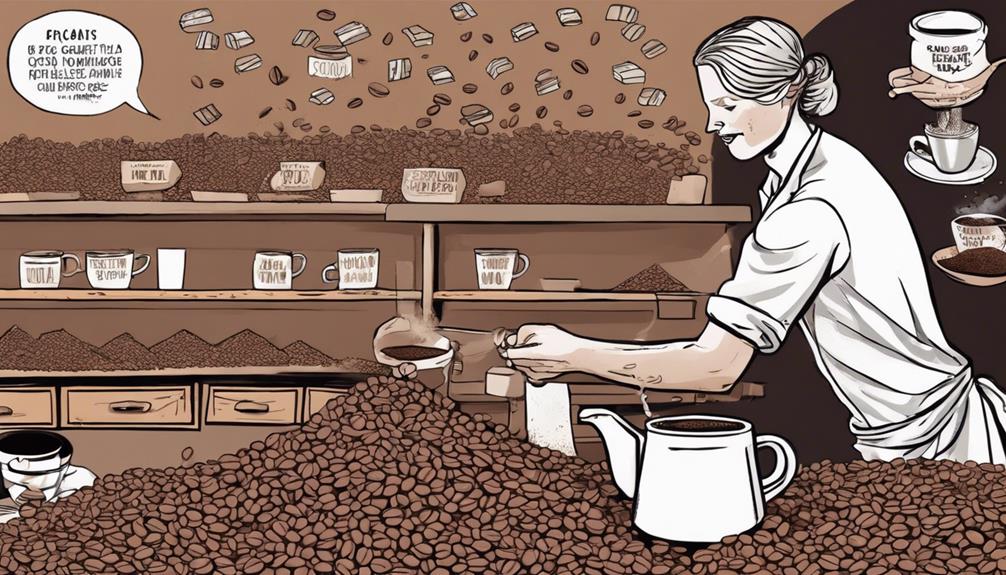
When it comes to chocolate flavors in coffee, the origin of the beans matters greatly. Regions such as Hawaii and parts of Central and South America are known for producing coffee beans with natural chocolate undertones.
Factors like soil composition and climate in these regions play an essential role in developing the rich chocolate notes found in the coffee beans.
Origin Influence on Chocolate
You may notice that the origin of coffee beans plays an essential role in the presence of chocolate flavors in your cup of coffee. The influence of where the coffee beans are grown can greatly impact the chocolate notes you experience.
Here's how origin affects the chocolatey undertones in your coffee:
- Volcanic Soil: Regions with volcanic soil, like Hawaii, often produce coffee beans with distinct chocolate flavors.
- Unique Microclimates: Central and South American regions with unique microclimates contribute to the rich chocolate undertones in coffee.
- Soil Composition: The soil composition in certain regions enhances the natural chocolate notes in the beans grown there.
- Climate: The climate of coffee-growing regions also plays an essential role in the prevalence of chocolate flavors in your coffee cup.
Understanding the origin influence on chocolate notes can help you appreciate and savor the diverse flavors present in different varieties of coffee.
Flavor Development Factors
Flavor development in coffee, particularly concerning the influence of origin on chocolate notes, is intricately tied to factors like soil composition, altitude, and climate in coffee-growing regions.
The origin of coffee beans plays a significant role in the presence of natural chocolate or cocoa flavors. Regions like Hawaii and Central America, with volcanic soil and unique microclimates, are known for producing coffee with chocolatey notes. These regions create an ideal environment for developing rich chocolate undertones in coffee beans.
Chocolate notes in coffee are inherent qualities of the beans, not the result of added flavoring. Additionally, different processing methods, such as wet or sun-dried processing, can further accentuate the potential for chocolatey flavors in the coffee beans.
Understanding these flavor development factors can help coffee enthusiasts appreciate and savor the intricate chocolate notes present in their favorite brews. Understanding the myriad of factors that contribute to flavor development in coffee, such as roast type, grind size, and brewing method, is crucial to bringing out flavor in coffee. By experimenting with these variables, coffee lovers can enhance the chocolatey undertones and rich flavors in their cup of joe. Additionally, paying attention to the origin of the coffee beans and the level of acidity can also play a significant role in bringing out flavor in coffee.
Roasting for Chocolate
Roasting coffee beans to a medium-dark level is essential for bringing out the inherent chocolate notes present in the beans. This pivotal step in the coffee-making process enhances the natural flavors and aromas that coffee enthusiasts crave.
When aiming to develop chocolate undertones in your coffee, consider the following:
- Origin Matters: Regions with volcanic soil and specific microclimates nurture natural chocolate flavors in coffee beans. The unique characteristics of the soil and climate play a significant role in the development of chocolate notes.
- Processing Methods: Different processing methods can enhance the potential for chocolate flavors in coffee. Whether it's washed, natural, or honey processed, the way coffee beans are handled post-harvest can impact the final taste profile.
- Roast Level: The roast level directly affects the presence of chocolate notes in your coffee. Opting for a medium-dark roast can intensify these flavors, providing a rich and decadent taste experience.
- Bean Selection: Choosing beans known for their chocolatey undertones can also contribute to a more pronounced chocolate flavor in your cup. Select beans with inherent chocolate notes to elevate your coffee experience.
Impact of Processing Methods
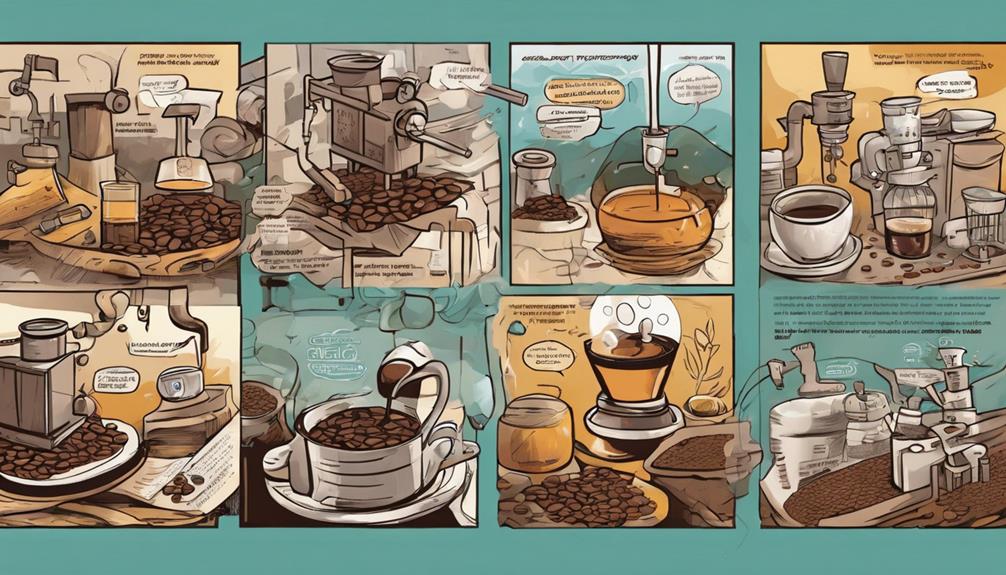
Among the vital factors influencing the chocolatey notes in coffee is the choice of processing methods, such as wet or sun-dried processes.
Coffee processing methods are pivotal in accentuating the inherent chocolate flavors present in the beans. These methods are carefully selected to bring out specific characteristics and enhance chocolate undertones.
The way coffee is processed significantly impacts its flavor profile, influencing the prominence of chocolate notes. By tailoring the processing techniques, coffee producers can highlight and intensify the chocolate flavors within the beans, contributing to the diverse range of flavor profiles available.
Different processing methods play a pivotal role in emphasizing the chocolatey aspects of coffee, offering a spectrum of flavors for coffee enthusiasts to explore.
Understanding how processing methods affect the flavor profile of coffee is key to appreciating the nuances of chocolate notes in your favorite brew.
Roasting for Chocolate Notes
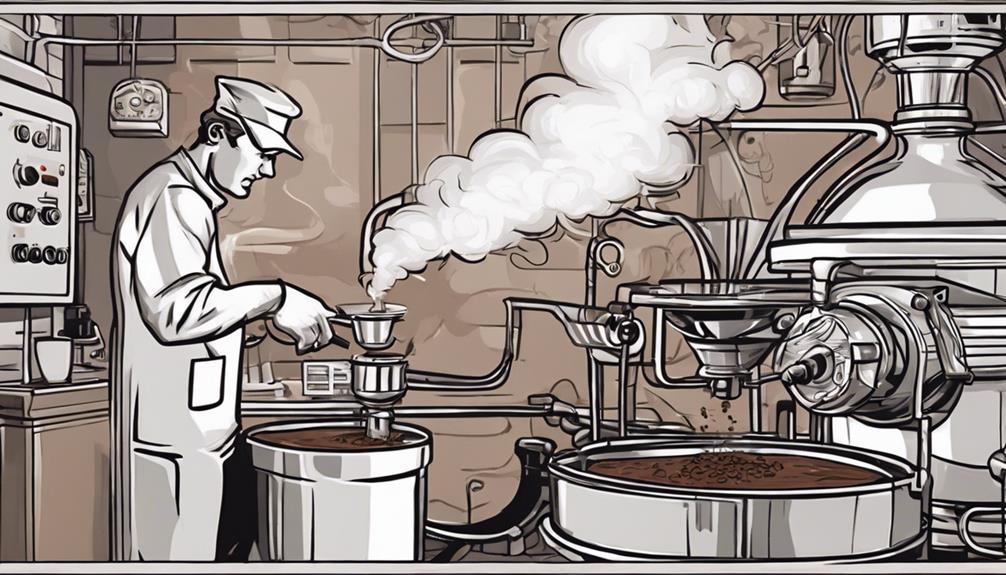
Enhancing the chocolatey essence of coffee beans can be achieved through skillful roasting techniques. Roasting plays an essential role in bringing out the desired chocolate notes in your coffee.
Here's how you can roast for chocolate notes:
- Opt for a medium-dark roast: Roasting coffee beans at a medium-dark level is known to accentuate the chocolate notes in your cup.
- Embrace darker roasts: Darker roasts, such as French or Italian roast, enhance cocoa and chocolate flavors, providing a rich and decadent taste.
- Understand the impact of roasting: Roasting is a pivotal factor in developing chocolate notes in coffee as different roast levels highlight various flavor profiles, including chocolatey undertones.
- Influence the flavor profile: Roasting influences the overall taste of your coffee, with the right roast level accentuating the chocolate notes you desire.
Homemade Extracts for Flavor Enhancement
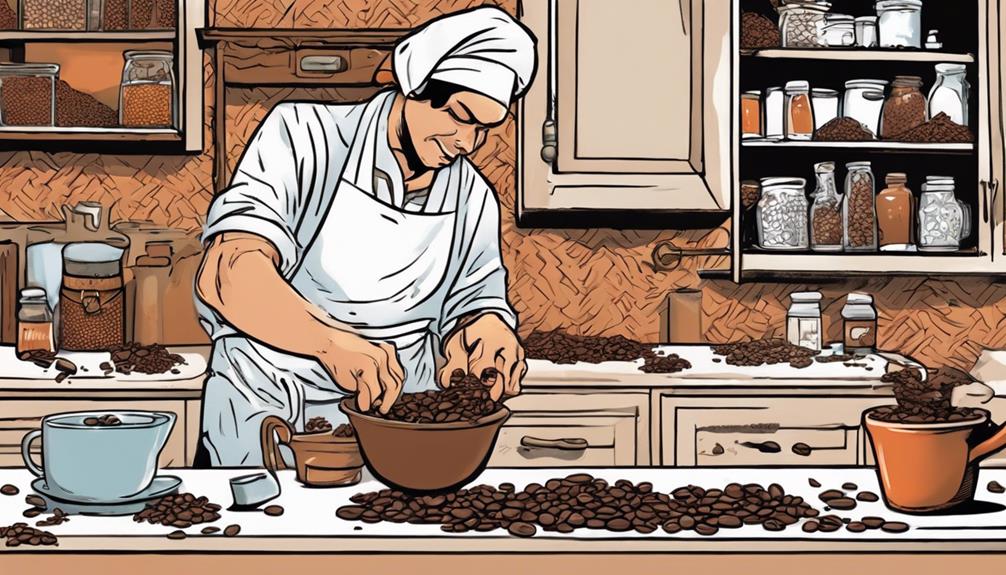
To enhance the flavors of your coffee further, consider creating homemade extracts for enhanced taste profiles. Homemade extracts can provide intense flavors for various recipes, including flavored coffee.
With just two ingredients, making extracts like chocolate and coffee at home isn't only cost-effective but also allows you to tailor the intensity to your preference. For instance, cold extraction is ideal for crafting rich vanilla extracts. These extracts require patience, needing 3-4 months to develop optimal flavor.
To ensure quality and longevity, store your homemade extracts in amber bottles in a cool, dark pantry.
Storage and Usage Tips
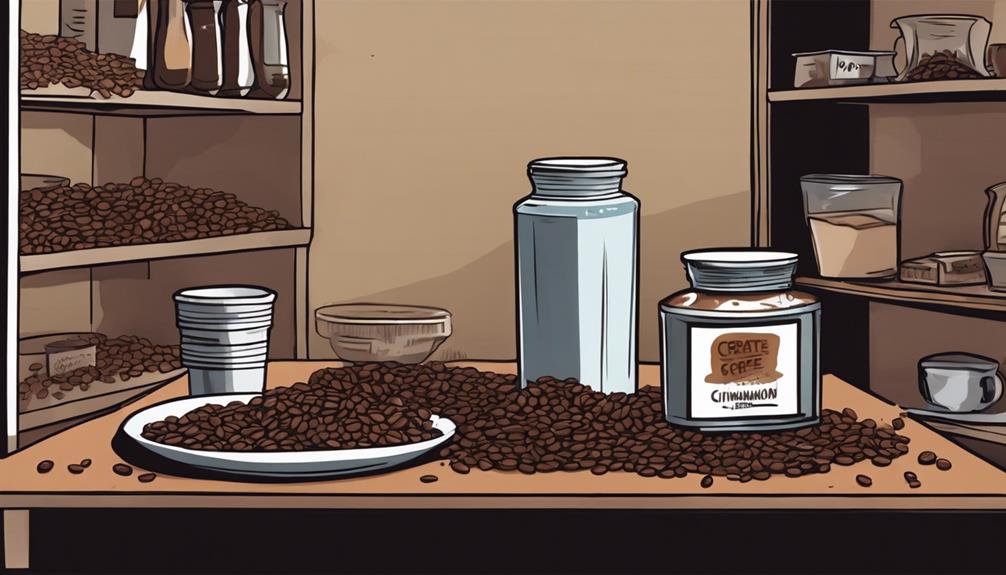
Keep your homemade extracts in amber bottles in a cool, dark pantry to maintain their quality and prevent light exposure. Avoid refrigerating the extracts to avert cloudiness caused by temperature changes. Proper storage in a dark, cool pantry can help the flavors last without compromising quality.
If extracts become cloudy due to light exposure or temperature changes, they're safe to use as long as they smell normal. To guarantee your extracts stay flavorful for an extended period, keep them away from heat, light, and extreme temperatures.
Enjoy these useful tips for storing and using your extracts:
- Store extracts in amber bottles in a cool, dark pantry.
- Avoid refrigeration to prevent cloudiness.
- Check for cloudiness and scent to assure safety.
- Keep extracts away from heat, light, and extreme temperatures.
Coffee and Chocolate Pairing Ideas

When combining coffee and chocolate, think about the pairing combinations that can create a flavor synergy. Match dark roasts with dark chocolate for a rich taste.
Or opt for fruity coffee with fruitier chocolates for a harmonious blend. Consider the similarities in flavors to enhance your tasting experience.
Pairing Combinations
For a delightful taste experience, consider pairing your coffee with complementary chocolate flavors. When it comes to creating the perfect coffee and chocolate combination, matching the flavors can elevate your sensory experience. Here are some pairing ideas to enhance your coffee enjoyment:
- Pair dark roasts with dark chocolate: Dark roasts, with their bold and robust flavors, harmonize well with dark chocolate (70%+) for a rich and intense taste sensation.
- Opt for light or blonde coffee with creamy chocolates: Lighter coffees complement creamier, lighter chocolates, creating a balanced and soothing pairing on your palate.
- Match nutty coffees with nutty chocolate: If you enjoy nutty flavors, try pairing nutty coffees with rich, nutty chocolate varieties for a delightful blend of similar notes.
- Experiment with fruity notes: Coffees with fruity undertones can enhance the fruity notes in chocolates, offering a dynamic and vibrant flavor combination for a unique tasting experience.
Flavor Synergy
To enhance your coffee and chocolate pairing experience, consider exploring the concept of flavor synergy to maximize the enjoyment of both beverages. When combining coffee and chocolate, paying attention to the flavor profiles can greatly elevate your tasting adventure. Here are some ideas to create harmonious pairings:
| Coffee Type | Chocolate Type | Flavor Synergy |
|---|---|---|
| Dark Roast | Dark Chocolate (70%+) | Rich and intense pairing. |
| Light/Blonde | Creamier, Lighter Chocolates | Balanced and smooth taste. |
| Nutty | Nutty Chocolate Varieties | Enhanced nutty notes for a harmonious match. |
| Fruity Notes | Fruity Chocolate Varieties | Vibrant and flavorful combination. |
| Similar Flavor Profiles | Matching Profiles | Enhances overall tasting experience. |
Frequently Asked Questions
How to Bring Out Chocolate Notes in Coffee?
To bring out chocolate notes in coffee, start by selecting beans with inherent cocoa qualities. Opt for darker roasts for intensified flavors. Consider the origin and processing methods for variations. Appreciate the natural sweetness or robustness in your brew.
How to Add Chocolate Flavour to Coffee?
To add chocolate flavor to coffee, imagine your cup as a canvas. Select beans with natural chocolate undertones, roast them medium to dark for a rich brew. Alternatively, infuse with chocolate extract or pair with chocolate desserts.
What Can I Add to Coffee to Make It Taste Like Chocolate?
To make your coffee taste like chocolate, you can try adding high-quality cocoa nibs or dark roast coffee for rich flavors. Infusing your brew with chocolate extract from cacao nibs can also enhance the taste.
How to Intensify Chocolate Flavor?
To intensify chocolate flavor, start by selecting beans from chocolatey regions and roasting them to a medium-dark level. Enhance with natural processing like sun-dried methods. Experiment with brewing techniques and pair with dark chocolate for a richer taste.
Conclusion
So, go ahead and indulge in the rich, decadent flavors of chocolate notes in your coffee.
With a little knowledge on the origin, processing methods, and roasting techniques, you can elevate your coffee experience to a whole new level.
Just like the perfect pairing of coffee and chocolate, finding balance in life is key.
Embrace the sweetness and richness that each day brings, and savor every moment to truly enjoy the flavors of life.









